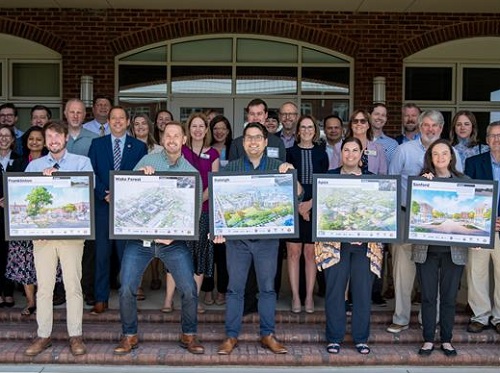A new study compiled by the North Carolina Department of Transportation is designed to help communities along the S-Line rail corridor in the central part of the state develop Transit Oriented Development or TOD projects.
[Above photo by NCDOT]
The agency explained that TOD creates a “compact development” mix of housing, office space, retail, civic spaces, and neighborhood amenities near a “mobility hub” that brings together in one location public transit, ride-sharing services, and other modes of travel.
The study explores the development along the S-Line rail corridor, which is a key missing link between Raleigh, NC, and Richmond, VA – a corridor that aims to improve rail connections between the Southeastern U.S. and Washington, D.C., and places further north.
[Editor’s note: The Federal Transit Administration recently made $13.4 million worth of grants available via a notice of funding opportunity through its Pilot Program for Transit-Oriented Development or TOD planning program. The application period closes on October 10.]

Through the TOD study, communities along the S-Line would leverage the future benefits of rail to plan for improved mobility and access, increased housing, downtown vibrancy, higher quality of life and economic vitality, the agency pointed out.
“The study is the result of a close partnership between NCDOT and the S-Line communities to understand how passenger rail can help each community achieve their goals,” noted Julie White, NCDOT deputy secretary for multimodal transportation, in a statement.
“From more affordable housing to more walkable vibrant town centers, the study provides guidance to the towns for how to make the most of the future passenger rail opportunity,” she said.
The S-Line TOD study evaluated market conditions, affordable housing considerations, multimodal transportation opportunities, and regulatory conditions in several central North Carolina communities – proposing transportation improvements that would meet a vision responsive to each communities’ needs.
The NCDOT integrated mobility and rail divisions partnered with seven North Carolina communities – Sanford, Apex, Raleigh, Wake Forest, Youngsville, Franklinton, Henderson, and Norlina – to complete the study. The process evaluated previous transportation planning efforts, the potential for real estate market demand, and affordable housing considerations.
Other planning factors included economic development, multimodal connectivity, environmental sustainability, and quality of life.
Each participating community received a “playbook” with recommendations to continue planning and development efforts. The “playbook” included sites to consider for transportation-focused development, a timeline for executing goals, and projects needed to complete multimodal transportation initiatives.
 States
States
Podcast: Flashing LED Lights Can Boost Roadway Safety
December 5, 2025 States
States

